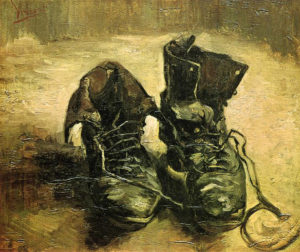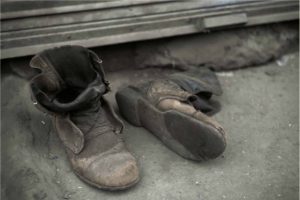Three Pairs of Shoes
 The first question to consider is how and why we need to remember?
The first question to consider is how and why we need to remember?
“How can the Gulag – a penal camp system already described by its contemporaries as the ‘quintessence’ of Soviet tyranny – be described, how can it be comprehended in all of its dimensions?” http://www gutepotenz.de/.dhm.de/ausstellungen/gulag/en/

Because of the disrespect that lies in forgetting and the dangerous complicity of ignorance, it is imperative to visit the trauma of others. There has never been a time where injustice and inequality have not occurred. The instances of which have been underestimated in our standard histories as most witnesses are often not given access to media. The question of how the representation of trauma can succeed in conveying to the viewer the realness of the events in a way that promotes change is paramount. Far worse than ignoring inequality is to misunderstand suffering and any documentary artist has to pay close attention to these issues or risk becoming part of the problem. It is this intention, which may be concurrent with other contexts of creative activity, that helps group documentary work as a genre within art practice. It is its active qualities, its political and social materialism which attracts me as an artist, and motivates me as a human being.
Objects that witness, as opposed to artists dramatisations after the fact, stand in for a direct contact with events beyond our horizon, and by being real they have the nature of proof and remembrance intertwined. They seem to shimmer so that a pair of boots becomes a symbol for all the miles walked through snow, by all the prisoners, the deliberate brutality and untimely deaths as well as a pair of boots worn by one or perhaps several prisoners of the Russian Gulag.

This image and the placement of the shoes remind me of Vincent Van Gogh’s “A Pair of Shoes, from 1886”. Could we learn something by comparing these two objects? If we cross boundaries from the suffering of a political prisoner (represented in the wear in the leather of the shoes) to the precincts of art and the suffering of the artist, which in Van Gogh case is well documented and a constant reference to the nature of his work. Are we connecting two wholly separate epistèmès, romanticising suffering to add value, to an idea or an art work or engaging in an act of remembering?
By questioning each objects functioning within our present value system can we bring light on the structures of meaning which operate in this example. Van Gogh’s painting has a huge value compared to a worn out a pair of shoes, what the actual shoes painted by Van Gogh? How does a photograph of a pair of shoes abandoned by the roadside contain the materiality implied in the previous two examples, the museum object, and the work of great art.
2 Comments
Comments are Disabled
Spot on with this write-up, I truly think this website needs much more consideration. I wiil in all probability be again to learn far more, thanks for that info.
I’ve been surfing on-line greater than three
hours as of late, but I by no means found any attention-grabbing article like yours.
It’s beautiful worth sufficient for me. In my view,
if all website owners and bloggers made good content as you probably did, the internet will likely be a lot more helpful than ever before.